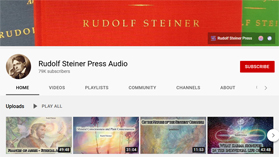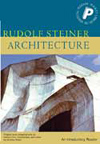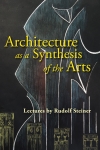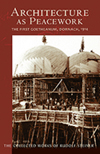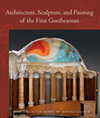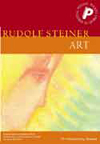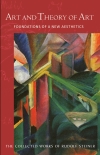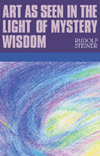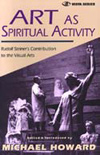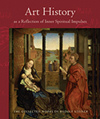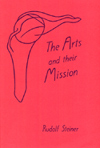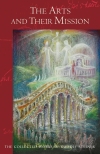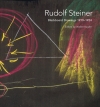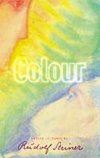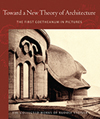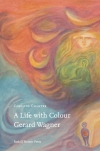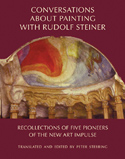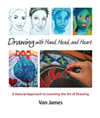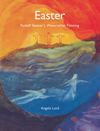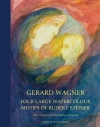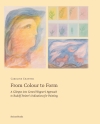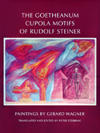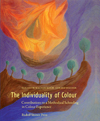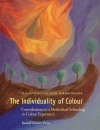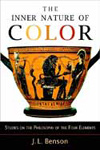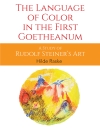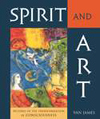
- RUDOLF STEINER
- OTHER AUTHORS
-
THE ARTS, GENERALRUDOLF STEINER
An Introductory Reader
Compiled with an introduction, commentary and notes by Andrew Beard
The origins and nature of architecture; The formative influence of architectural forms; The history of architecture in the light of mankind's spiritual evolution; A new architecture as a means of uniting with spiritual forces; Art and architecture as manifestations of spiritual realities; Metamorphosis in architecture; Aspects of a new architecture; Rudolf Steiner on the first Goetheanum building; The second Goetheanum building; The architecture of a community in Dornach; The temple is the human being; The restoration of the lost temple.
ARCHITECTURE AS A SYNTHESIS OF THE ARTS
This unique collection of lectures introduces Rudolf Steiner’s vision of architecture as a culmination of the arts, uniting sculpture, painting and engraving as well as drama, music and dance – a vital synthesis with the goal of awakening human beings to their task in life.
The First Goetheanum, Dornach, 1914
“We need to create an energetic culture of peace—not idle talk of peace, but the real peace that can arise only out of a concrete, mutual understanding of the various individual cultures.”
—Rudolf Steiner (lecture 2)ARCHITECTURE, SCULPTURE, AND PAINTING OF THE FIRST GOETHEANUM
“This spiritual science should not be anything abstract, nothing theoretical, nothing unworldly, nothing unreal.... Thus, it had to create for itself an architectural style, a framework that arises from it as a nutshell from a kernel. Of course, one will be able to raise many objections, and they stand before my soul. But one thing was encouraging in a sense; something went through my soul as I worked on this architectural thought in all its details. When I was a very young man in the 1880s, I heard the Viennese architect [Heinrich] von Ferstel, who built the Votive Church in Vienna, give his commencement address about the development of architectural styles. With a certain emphasis, the great architect Ferstel cried out, ‘Architectural styles are not invented; they arise!’ I have always told myself that we live in an age today when everything spiritual has to be transformed in the human soul so that a new architectural style must arise from this transformation of spirit. The possibility of such a thing always stood before my soul.... One learns through encountering reality when not dealing with abstract ideas, symbols, and allegories, but rather with living art and real life. Spiritual Science needs at least the beginnings of a new architectural style and a new artistic language of forms. It may be imperfect [but] present human civilization demands it!” —Rudolf Steiner
An Introductory Reader
Compiled with an introduction, commentary and notes by Anne Stockton
The being of the arts; Goethe as the founder of a new science of aesthetics; Technology and art; At the turn of each new millennium; The task of modern art and architecture; The living walls; The glass windows; Colour on the walls; Form - moving the circle; The seven planetary capitals of the first Goetheanum; The model and the statue 'The Representative of Man'; Colour and faces; Physiognomies.
Introduction by Zvi Szir
“The challenge of saying something about art was personal for Rudolf Steiner. He experienced it as deeply connected with his biography. It is not for nothing that, in the last lecture of this volume, he points to his repeated attempts to develop a new approach and new forms of expression for speaking about art. We find at least three forms of this attempted approach in this book.” —Zvi Szir (from the introduction)
ART AS SEEN IN THE LIGHT OF MYSTERY WISDOM
Within the Mystery cultures of ancient history, art, science and religion formed a unity that offered direction and spiritual nourishment to the broader society. Today, art, science and religion can again be reunited. However, as Marie Steiner indicates in her introduction to these lectures, these aspects of our culture need rejuvenation through fresh spiritual understanding and knowledge. Art cannot be renewed through compromise, but only by returning to the spiritual foundations of life. As she says: "The remedy lies in unlocking the wisdom of the Mysteries and presenting it to humanity in a form adapted to contemporary needs."
Rudolf Steiner's Contribution to the Visual Arts
This book introduces a new way for thinking about, creating, and viewing art. Rudolf Steiner saw his task as the renewal of the lost unity of science, the arts and religion; thus he created a new, cognitive scientific and religious art. The implications of his act - recognized by such diverse artists as Wassily Kandinsky and Joseph Beuys - are only now coming fully to light. In his thorough introduction Michael Howard takes readers through these thought-provoking chapters.
as a Reflection of Inner Spiritual Impulses
"I am going to show you a series of reproductions, of slides, from a period in art history to which the human mind will probably always return to contemplate and consider; for, if we consider history as a reflection of inner spiritual impulses, it is precisely in this evolutionary moment that we see certain human circumstances, ones that are among the deepest and most decisive for the outer course of human history, expressed through a relationship to art." —Rudolf Steiner
ARTISTIC SENSITIVITY AS A SPIRITUAL APPROACH TO KNOWING LIFE AND THE WORLD
Today’s orthodox notions of science—which is to say, of knowing—are exceedingly narrow; they posit, implicitly or otherwise, that the only knowledge possible, if any, is that of the physical world. But the skeleton key to unlocking the door, behind which lies the root of the problems and difficulties of our age, and thus their solution, is to be able to fully answer this question: What is it to know something? This question lies at the foundation of spiritual science. Rudolf Steiner had first to solve it for himself, pointing the way for others to do the same (in, for example, his Philosophy of Freedom), long before he could give such lectures as these.
Steiner's extraordinary insights on architecture, sculpture, painting, drama, costuming, music, poetry, eurythmy and more.
8 lectures, Oslo and Dornach, May 18 – June 9, 1923 (CW 276)
BLACKBOARD DRAWINGS, 1919–1924
Edited by Walter Kugler
‘Did Rudolf Steiner dream these things? Did he dream them as they once occurred, at the beginning of all time? They are, for sure, far more astonishing than the demiurges and serpents and bulls found in other cosmogonies.’ – Jorge Luis Borges
Building on the achievements of Goethe in his Theory of Colour, Rudolf Steiner shows how colour affects us in many areas of life, including our health, our sense of well-being, and our feelings. Distinguishing between 'image' and 'lustre' colours, he lays the foundation, based on his spiritual-scientific research, for a practical technique of working with colour that leads to a new direction in artistic creativity.
TOWARD A NEW THEORY OF ARCHITECTURE
The First Goetheanum in Pictures
“Yes, we really did try to carry out an architectural program here that was unprecedented, but it had to happen. If others hadn’t dared to do such a thing at various times, there never would have been progress in the evolution of humanity.” —Rudolf Steiner
-
THE ARTS, GENERALOTHER AUTHORS
Gerard Wagner
Caroline Chanter
A Life with Colour is the first complete survey of Gerard Wagner’s biography and his artistic intentions, featuring dozens of illustrations and more than 120 colour plates.
Gottfried Richter
“Gottfried Richter's Art and Human Consciousness is a significant book because it illustrates a way of reading art experientially, whereby the art object is an expression of a particular epoch's human experience and consciousness, particularly in regard to spiritual experience.” —Impressions, 1988
CONVERSATIONS ABOUT PAINTING WITH RUDOLF STEINER
Recollections of Five Pioneers of the New Art Impulse
Peter Stebbing
The purpose of this illustrated volume of first-hand recollections is to increase appreciation in the world for Rudolf Steiner's artistic contributions to modern culture. The authors represented in Conversations about Painting with Rudolf Steiner offer insights into Steiner's intentions as he responded to artists' questions about the deeper, spiritual aspects of painting, color, and role of the arts as a whole in culture and society.
DRAWING WITH HAND, HEAD AND HEART
A Natural Approach to Learning the Art of Drawing
Van James
Drawing with Hand, Head, and Heart is a comprehensive and practical guide to the art of drawing and to the process of visual thinking that is part of our full human intelligence. More than 500 illustrated exercises and examples—collected and developed over many years of Waldorf classroom experience—show teachers, parents, and students how to learn to draw simply and naturally, as a child would learn to draw.
Rudolf Steiner's Watercolor Painting
Angela Lord
This marvellous book explores the deep meaning of the watercolour Easter (or "Three Crosses") painted by Rudolf Steiner in April 1924. Living through this book into Steiner's watercolour painting, the reader is led to contemplate the profound mysteries of not only colours and the sense world, but also the divine, cosmic, human invisible reality lying behind them and manifested in the unique event we celebrate as Easter.
FOUR LARGE WATERCOLOUR MOTIFS OF RUDOLF STEINER
With a Lecture by Rudolf Steiner on Raphael
Gerard Wagner
Rudolf Steiner
“The art of the future will be an art of inner maturity. What leads to artistic activity will be sensed only at a relatively advanced age in life. It will no longer be assumed that one cannot have the necessary youth forces for artistic creation in later years—as is still often asserted today. It will be found that only by way of inner deepening augmented by spiritual scientific insight are the forces released that lead to artistic creation.” —Rudolf Steiner, Dornach, February 7, 1915
A Glimpse into Gerard Wagner's Approach to Rudolf Steiner's Indications for Painting
Caroline Chanter
This book offers insight into how Gerard Wagner developed his work on the basis of Rudolf Steiner’s indications for painting. Fundamental colour experiments illustrate his methodical approach, while examples of his late work show the living, etheric quality he achieved in his watercolour painting. In appreciation of Rudolf Steiner’s contribution toward the evolution of painting, Wagner wrote the following:
“Whoever attempts to tread this path can come to the conviction that the indications of Rudolf Steiner, if they are sufficiently penetrated and experienced, can lead one to grasp the creative formative forces of colour and to create within this life element without harming it. By giving us such pictures of life shaped by colour, Rudolf Steiner has set goals for a far future of painting.”THE GOETHEANUM CUPOLA MOTIFS OF RUDOLF STEINER
Paintings by Gerard Wagner
"Along with the architectural and sculptural forms of the double-domed first Goetheanum, the cupola paintings further epitomized the artistic conception of this unique building. The painting motifs extending over the surface of the two cupolas encompassed the evolution of the world as a whole, from its creation by the biblical Elohim to the great epochs of Lemuria and Atlantis that followed. Traversing the post-Atlantean cultural epochs, the beholder was gradually led to the building's central motif: the Mystery of Golgotha as the mid-point of world evolution, with its implications for the future development of the Earth and humanity." - Sergei O. Prokofieff (from his foreword)
Contributions to a Methodical Schooling in Colour Experience
Foreword by S.O. Prokofieff
Elisabeth Wagner-Koch
Gerard Wagner
'What is postulated here is not the dogmatic laying down of a way of working. Rather the aim is to make evident one possible means of access to an experience of the colour world... and guide actual practice to Rudolf Steiner's sketch motifs - to their eminent educational power - for we recognize in them a path that can become of great significance to the developing human soul.' - From the Introduction
Contributions to a Methodical Schooling in Colour Experience
Elisabeth Wagner-Koch
Gerard Wagner
‘What is postulated here is not the dogmatic laying down of a way of working. Rather the aim is to make evident one possible means of access to an experience of the colour world... and guide actual practice to Rudolf Steiner’s sketch motifs – to their eminent educational power – for we recognize in them a path that can become of great significance to the developing human soul.’ – From the Introduction
Studies on the Philosophy of the Four Elements
J.L Benson
In this fascinating work, J. Leonard Benson describes the spiritual and esoteric nature of color in relation to the four elements-fire, earth, air and water. Based on insights provided by Rudolf Steiner and a deep knowledge of classical cosmology and color theory, this book shows how an understanding of the inner nature of color leads to a completely different view of the world and evolution than is current in our present civilization - one completely at odds with the ruling neo-Darwinian paradigm.
THE LANGUAGE OF COLOR IN THE FIRST GOETHEANUM
A Study of Rudolf Steiner’s Art
Hilde Raske
Rudolf Steiner’s architectural masterpiece, the double-domed building known as the first Goetheanum, featured decorated ceilings that were designed and partly painted by Steiner himself, utilizing vegetable colors and a new layering technique. Steiner emphasized that he was seeking a new artistic conception based on a conscious understanding of the nature of color. Contemporaries report the extraordinary effect of the domed ceilings’ paintings combined with the multicolored light emanating from the engraved glass windows.
Pictures of the Transformation of Consciousness
Van James
Art, originally a part of the secret mystery cults of the ancient world, has become an expression of the individual creative intuition. This richly readable and lavishly illustrated text reveals how human consciousness has evolved through the medium of art. It makes the case for a hidden stream that has put forth art works and art movements throughout history, in an ongoing visible revelation of invisible spiritual currents.
An Introduction to Anthroposophic Medicine and Study of the Human Being
Armin J. Husemann, MD
“You take all of Nature together to shed light on individual details; in the totality of her phenomena, you seek to explain the individual. From simple levels of organization, you ascend to the more complex, ultimately assembling the most complex of all—the human being.”—Friedrich Schiller (in a letter to Goethe)

